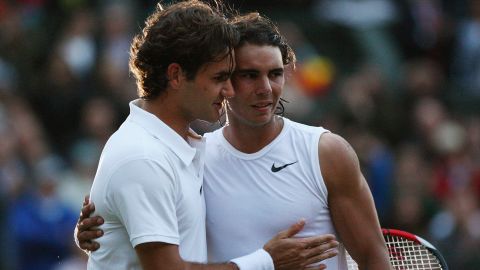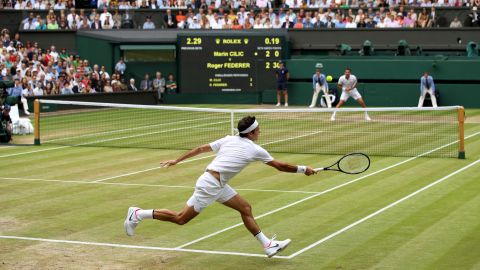CNN
—
We are living through a time when the expected surprised. In life there is always an end. Always. We know that. We assume so. We’re trying to prepare for that. But when the passage of time inevitably forces a chapter to close, the reality of it all still stuns like a thunderbolt.
Roger Federer wouldn’t play tennis forever. At the age of 41 and having suffered injury after injury over the past few years, sand quickly trickled to the bottom of the hourglass. Even great champions retreat.
But like Serena Williams, Federer had changed the expected arc of a tennis player’s career. In their fourth decades, they continued to rack up titles and break records, cementing their greatness. Incredibly, in their five decades, they were both still present.
While their longevity allowed us to appreciate their talents, to enjoy every tournament and every year that has passed, it also gave us a false sense of security in believing that they would always be there, even if injuries protracted in later years led to absences. They would come back. They kept coming.
Federer won his first of 20 Grand Slams in 2003, at a time when people were raving about the latest Nokia phone and before the United States and Britain had started a war in Iraq. With a 24-year professional career, Federer had become a fixture in our sporting lives. While we were all getting older – quietly and slowly – Federer was still playing, still winning, defying time and fooling us into believing that neither the world nor we had changed the a lot of.
But on Thursday – two weeks after Williams was expected to play her last professional game – we had to admit we were entering a new era.
“I need to recognize when it’s time to retire from my competitive career,” said Federer when announcing that he would retire after next week’s Laver Cup in London.
“I’ve worked hard to be fully competitive again. But I also know the capacities and limitations of my body and its message to me has been clear lately.”
The Swiss has not played competitively since Wimbledon last summer after undergoing a third knee surgery that ultimately forced one of tennis’s most incredible careers to end without the success it deserved.
Federer became the first man to collect 20 Grand Slam titles. Still, no other man has won as many as his eight Wimbledon titles, played as many (429) or won as many Grand Slam matches (369). He exits the sport with 103 titles, second only to Jimmy Connors in the Open Era, and more than $130 million in prize money.
During a five-year period early in the century, when he won 12 out of 18 Grand Slams, Federer redefined the meaning of tennis brilliance in the men’s game.
Many of the outstanding records he set were broken by Rafael Nadal or Novak Djokovic, the other outstanding talents who later rose to prominence and made the last 15 years the sport’s golden age.
Federer had spent 310 weeks as world number one; Djokovic surpassed this feat. Nadal now has 22 major titles, Djokovic 21.
It’s likely that one day all of Federer’s records will be broken, but the numbers only reflect a fraction of Federer’s genius. A Google search of its stats doesn’t explain its size or appeal. This is a man who has won the fan favorite award at the year-end ATP Awards for 19 straight years.

Federer is not only praised for winning, but also for the way he won, for the way he played. No one has honored a court like him. Will we see his like again? Maybe, but it would be a player.
Was there a better forehand in the game? A sweeter backhand? A more effective serve? At least in the men’s game, as Williams’ serve is widely considered to be the best ever. Has anyone played a sport with such a beauty?
“It’s like a symphony,” is how Patrick Mouratoglou, Williams’ former coach, described Federer’s style a few years ago.
“Nobody will ever play tennis like that, impossible. It’s just perfection. The movement, the timing, everything is perfect and that’s incredible.”
Acclaimed author David Foster Wallace described the Federer forehand as a “great liquid whip” in his 2006 essay “Roger Federer as a Religious Experience” in The New York Times. The genius of Federer’s game, Wallace explained, was lost on television.
Federer was a young man when the essay was written, but already at 25, Wallace was not alone in calling him the greatest man ever.
Of course there were good players on the tour, but nobody who could live with Federer’s quick wit and intelligence on the pitch in the long term. he was so good
Six years before Wallace’s essay was published, nobody thought that Pete Sampras’ record of 14 Grand Slam titles would be broken – then came Federer, later along with Nadal and Djokovic the ‘Big Three’.
Now, of course, there are those who will argue that Nadal has proven to be the greatest of all time or that Djokovic is a better all-rounder. Maybe maybe.

The balance of power may have shifted, but what’s undeniable is that neither Nadal nor Djokovic are as aesthetic as the Swiss.
Watching Federer play in 3D is – and there’s just time to talk about his style in present tense – fascinating. It was, sorry, is something special, a I was there Moment to be told and retold to grandchildren or anyone who will listen. Nobody has made sport at the highest level seem so effortless.
The annals of sports history will place Federer alongside the likes of Michael Jordan, Muhammad Ali, Tiger Woods and of course Serena Williams. Game changers everyone who has transcended their sport, who is still being talked about years after their retirement and who inspire generation after generation.
Tennis goes into a new future. Federer is set to retire soon, Nadal, at 36, probably won’t be playing at the same age as his friend and rival, such has been his injury history, and Djokovic is 35, still capable of racking up more major titles but he ages anyway.
We knew one day it would happen. But as we know, it takes time to adapt to change.
